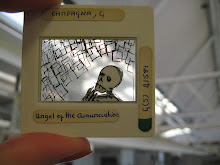Critical Review
Stuart Croft – Drive In
Ruby Lloyd-Burman
INT. TETHER ART GALLERY – DAY
ART PUNTER 1 is stood outside Stuart Croft’s Drive In idly flicking through the exhibition publication. ART PUNTER 2 approaches AP1.
AP2
(Pointing)
What’s in here?
AP1
(Bored tone)
A Slick, well-lit film. Running time: infinity or until you turn the fucking thing off.
AP2
(Questioning look)
…
AP1
(Bored tone)
Whole thing takes place within a car. It’s raining outside. The man drives. The woman is telling a story, full of slang, conversational language, archetypes and mystic imagery.
A large section of the story follows a typical romance story, only the setting is unusual – castaways on desert islands. Boy meets girl. Guy’s a stiff; girl’s a mystical, beautiful, resourceful, sexy artist.
AP1 pauses for breath
AP1
(Bored tone)
He decides to write a semiautobiographical story in blood. She reads it and gives honest and not very positive feedback. He goes off in a huff ‘to get some space, or some shit like that’ and has an affair gets an STD; the relationship breaks apart he leaves, starts to miss her then the story repeats as he is again washed ashore an island and meets a mystical, beautiful, resourceful, sexy artist.
Male actor is passive but attentive to his passenger’s story.
AP2
(Hastily)
Whoa, whoa! Don’t tell me every detail.
AP2 goes into the curtained space. AP1 is left to read the publication again. AP2 returns after 10 minutes
AP2
It’s very dark in there.
I bumped into a chair.
AP1 looks up from the publication at AP2
AP2
I found the darkness distracting, until the story she tells sucked me in. Then, I dunno, the darkness sort of became like a, a metaphor…
AP1
(Non-committal noise)
AP2
Do you think the woman in the story is the same as the woman in the car?
AP1
(Cocks head pensively)
AP2
(Continuing)
Is the driver the same as the man in the story?
AP1
(Matter-of-factly)
I think the relationship between the characters in film and the characters in the story is ambiguous. As is the relationship between the male and female character.
AP2
But she talks like it’s happened to her, like she’s recalling something very real (despite the fantastical nature of the story).
How it’s shot echoes that too – pauses where the camera lingers on her face, or her hands.
AP1
(Nodding in agreement)
She tells the story emphatically, which throws you off. Her emotional involvement makes you think the story could be about the current relationship in the car, a past relationship of the storytellers, or an account of something that happened to someone once.
Hell, it could even be an analogy for every modern relationship.
AP2
(Considered)
It might not even be about ‘relationships’ at all
AP1
(Defensive)
Well, yeah, obviously.
There is an uncomfortable pause. AP2 re-enters the exhibition space. AP1 hesitates for a couple of minutes then joins AP2. They both reappear 10 minutes later.
AP2
(Slowly)
I really like it. It’s…it feels like you know when you look in a mirror reflecting another mirror.
You can see yourself reflected into infinity.
The cut is seamless – it’s difficult to tell where the film begins and where it ends.
AP1
I don’t think there is an ending, or a beginning. The characters are trapped, like your reflection is trapped in the two mirrors.
AP2
(Sound of agreement)
…so is it repetition that leads to entrapment?
AP1
I’m not sure it could even be called repetition. Repetition suggests an action and time. It also suggests a mastery of something, a resolve, an ending.
But this film seems timeless – there’s no future. It’s not like she repeats the story, ‘cause then it’d vary slightly; different intonation here, different word there. It’s just, the same.
AP1 pauses in thought, AP2 shuffles awkwardly.
AP1
There’s no retelling of the story in Drive In, there is no revision, no history, no future. We are all stuck.
AP2
(As if remembering something once known)
AP1
(Enthusiastically)
“There is, unequivocally, no resolve. And it’s about … its inherent condition of circularity, of irresolution if that’s the correct word, in order to manifest entrapment and denial and recurrence.” [ii]
AP2
There’s no way out for the characters. And no way out for the audience – you’re never given the next scene.
AP1
Croft is messing with expectations of cinema, of Hollywood – why else would he make the film look so slick and sexy? It could be lifted from a big budget film. It’s called Drive In, if that doesn’t scream American cinema, I don’t know what does. Drive. In.
AP2
People in their cars, in their own atmospheres going in. Bubbles within bubbles. Reflection within reflections.
AP1
It’s insular – the characters stay within the car for the whole film, protected from the elements. Just like when you watch a film, you can choose to not get emotionally involved. The silver screen protects you; you’re given the luxury to just observe, but observe intimate things without having to take responsibility.
AP2
It’s like, he’s taken Hollywood’s language and told an anti story, with an anti plot.
AP1
I don’t know if I’d go that far…maybe. I’m not sure. All I know is, the narrative is never resolved it never develops. It just stays painfully the same.
AP2
I guess it then comes down to the viewer – you decide when it ends.
AP1
Yeah but characters can’t.
You’re lucky.
AP1 replaces the exhibition publication, nods at AP2 and leaves. AP2 picks up and idly flicks through publication. AP3 arrives, looks around with an air of uncertainty. AP3 stops at the entrance of exhibition space and looks to AP2.
AP3
(Pointing)
What’s in here?

0 comments:
Post a Comment